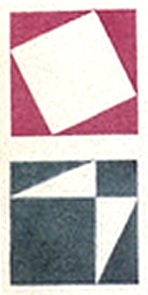Or: "A Hologram for the King" Meets "Big"
* A reference to an alleged motto of Plato's Academy
See Bagombo Snuff Box and
"Will this be on the test?"

Your mission, should you choose to accept it…
See also “Mapping Music” from Harvard Magazine , Jan.-Feb. 2007—
“Life inside an orbifold is a non-Euclidean world”
— as well as the cover story “The Shape of Music” from Princeton Alumni Weekly ,
Feb. 9, 2011, and “Bead Game” + music in this journal (click, then scroll down).
Those impressed by the phrase “non-Euclidean” may also enjoy
Non-Euclidean Blocks and Pilate Goes to Kindergarten.
The “Bead Game” + music search above includes, notably, a passage describing a
sort of non-Euclidean abacus in the classic 1943 story “Mimsy Were the Borogoves.”
For a visually related experience, see the video “Chord Geometries Demo: Chopin
on a Mobius Strip” at a music.princeton.edu web page.
* Motto of the American Mathematical Society, said to be also the motto of Plato’s Academy.
Friday March 31, 2006
|
"The purpose of mathematics cannot be derived from an activity
inferior to it but from a higher sphere of human activity, namely,
religion."
— Igor Shafarevitch, 1973 remark published as above in 1982.
"Perhaps."
— Steven H. Cullinane, February 13, 2019
|
From Log24 on Good Friday, April 18, 2003 — . . . What, indeed, is truth? I doubt that the best answer can be learned from either the Communist sympathizers of MIT or the “Red Mass” leftists of Georgetown. For a better starting point than either of these institutions, see my note of April 6, 2001, Wag the Dogma. See, too, In Principio Erat Verbum , which notes that “numbers go to heaven who know no more of God on earth than, as it were, of sun in forest gloom.” Since today is the anniversary of the death of MIT mathematics professor Gian-Carlo Rota, an example of “sun in forest gloom” seems the best answer to Pilate’s question on this holy day. See
“Examples are the stained glass windows Motto of Plato’s Academy † The Exorcist, 1973 |
Detail from an image linked to in the above footnote —
"And the darkness comprehended it not."
Id est :
A Good Friday, 2003, article by
a student of Shafarevitch —
"… there are 25 planes in W . . . . Of course,
replacing {a,b,c} by the complementary set
does not change the plane. . . ."
Of course.
See. however, Six-Set Geometry in this journal.
Updates of 9:40 PM ET Jan. 10
to 5:45 AM ET the next day:
See a letter from the AMS on their new logo.


Recent revision (pre-2018) of the former AMS logo
The Society's letter describes perceptions of the pre-2018 logo —
"… market research on our current logo revealed that
the connection between a Greek temple and
a mathematical society has become increasingly tenuous
among non-members and younger mathematicians, who
associate the Greek temple with a financial institution."
The omission of the alleged motto of Plato's Academy,
AGEOMETRETOS ME EISITO, in the recent (pre-2018)
revision of the logo was part of the Society's ongoing
process of politically correct dumbing-down. That omission
may have influenced the perception of the logo as picturing
a Greek temple rather than the Academy.
Some related remarks from 2005 —
"Ageometretos me eisito."—
"Let no one ignorant of geometry enter."—
Said to be a saying of Plato, part of the
seal of the American Mathematical Society—

For the birthday of Marissa Mayer, who turns 41 today —
VOGUE Magazine,
AUGUST 16, 2013 12:01 AM
by JACOB WEISBERG —
"As she works to reverse the fortunes of a failing Silicon Valley
giant, Yahoo’s Marissa Mayer has fueled a national debate
about the office life, motherhood, and what it takes to be the
CEO of the moment.
'I really like even numbers, and
I like heavily divisible numbers.
Twelve is my lucky number—
I just love how divisible it is.
I don’t like odd numbers, and
I really don’t like primes.
When I turned 37,
I put on a strong face, but
I was not looking forward to 37.
But 37 turned out to be a pretty amazing year.
Especially considering that
36 is divisible by twelve!'
A few things may strike you while listening to Marissa Mayer
deliver this riff . . . . "
Yes, they may.
A smaller number for Marissa's meditations:
Six has been known since antiquity as the first "perfect" number.
Why it was so called is of little interest to anyone but historians
of number theory (a discipline that is not, as Wikipedia notes,
to be confused with numerology .)
What part geometry , on the other hand, played in Marissa's education,
I do not know.
Here, for what it's worth, is a figure from a review of posts in this journal
on the key role played by the number six in geometry —

G. H. Hardy in A Mathematician's Apology —
|
What ‘purely aesthetic’ qualities can we distinguish in such theorems as Euclid’s or Pythagoras’s? I will not risk more than a few disjointed remarks. In both theorems (and in the theorems, of course, I include the proofs) there is a very high degree of unexpectedness, combined with inevitability and economy. The arguments take so odd and surprising a form; the weapons used seem so childishly simple when compared with the far-reaching results; but there is no escape from the conclusions. There are no complications of detail—one line of attack is enough in each case; and this is true too of the proofs of many much more difficult theorems, the full appreciation of which demands quite a high degree of technical proficiency. We do not want many ‘variations’ in the proof of a mathematical theorem: ‘enumeration of cases’, indeed, is one of the duller forms of mathematical argument. A mathematical proof should resemble a simple and clear-cut constellation, not a scattered cluster in the Milky Way. |
Related material:

"The Cardinal seemed a little preoccupied today."
See also a post found via a search in
this journal for "April 19 ".
“Why Is Our Sci-Fi So Glum About A.I.?,”
by Jayson Greene, NY Times Sunday Magazine today —
“You come to pity these advanced beings, bumping against
the dunderheaded constraints that their less-advanced
creators have placed on them. Johansson’s Lucy grows so
powerful as her cerebral capacity multiplies that she is able
to manipulate her cellular structure. And yet, when pursued
by an entire planet’s worth of law enforcement, she settles
on a disguise straight out of Saturday-morning cartoons —
really big sunglasses and a hairdo change.”
See also this journal on Saturday morning for a definition, and
Geometry of the I Ching for examples, of …
changeable, instantiable entities, i.e., concrete universals.

MEDEIS AGEOMETRETOS EISITO
— Inscription at entrance to
Plato's Academy, according to
an elementary introduction to
philosophy by James L. Christian
For Irving Adler, who reportedly
died on September 22, 2012—
|
|
Background: See Sangaku in this journal.
See also the following, from a different
elementary introduction, by Adler—
Giant Golden Book of Mathematics,
illustrated by Lowell Hess—
 .
.
(Detail of Flickr photo)
* See Liddell and Scott.

| “Three times the concentred self takes hold, three times The thrice concentred self, having possessed The object, grips it in savage scrutiny, Once to make captive, once to subjugate Or yield to subjugation, once to proclaim The meaning of the capture, this hard prize, Fully made, fully apparent, fully found.” — “Credences of Summer,” VII, |
Previous entry,
entries of July 1, 2007,
and A Little Story
(9/30/06)
Women's History Month continues…
Ontology Alignment
"He had with him a small red book of Mao's poems, and as he talked he squared it on the table, aligned it with the table edge first vertically and then horizontally. To understand who Michael Laski is you must have a feeling for that kind of compulsion."
— Joan Didion in the
Saturday Evening Post,
Nov. 18, 1967 (reprinted in
Slouching Towards Bethlehem)
"Or were you," I said.
He said nothing.
"Raised a Catholic," I said.
He aligned a square crystal paperweight with the edge of his desk blotter.
— Joan Didion in
The Last Thing He Wanted,
Knopf, 1996
"It was Plato who best expressed– who veritably embodied– the tension between the narrative arts and mathematics….
Plato clearly loved them both, both mathematics and poetry. But he approved of mathematics, and heartily, if conflictedly, disapproved of poetry. Engraved above the entrance to his Academy, the first European university, was the admonition: Oudeis ageometretos eiseto. Let none ignorant of geometry enter. This is an expression of high approval indeed, and the symbolism could not have been more perfect, since mathematics was, for Plato, the very gateway for all future knowledge. Mathematics ushers one into the realm of abstraction and universality, grasped only through pure reason. Mathematics is the threshold we cross to pass into the ideal, the truly real."
— Rebecca Goldstein,
Mathematics and
the Character of Tragedy
To the Society of Jesus (also known as the Jesuits):
Have a Good Friday, Traitors

†
Prompted by Pilate’s question “What is truth?” and by my March 24 attack on Noam Chomsky, I decided this afternoon to further investigate what various people have written about Chomsky’s posing of what he calls “Plato’s problem” and “Orwell’s problem.” The former concerns linguistics, the latter, politics. As my March 24 entry indicates, I have nothing but contempt for both Chomsky’s linguistics and Chomsky’s politics. What I discovered this afternoon is that Georgetown University, a Jesuit institution, in 2001 appointed a Chomskyite, David W. Lightfoot, as Dean of the Graduate School of Arts and Sciences.
“Why do we know so much more than we have evidence for in certain areas, and so much less in others? In tackling these questions — Plato’s and Orwell’s problem — Chomsky again demonstrates his unequalled capacity to integrate vast amounts of material.” — David W. Lightfoot, review of Chomsky’s Knowledge of Language
What, indeed, is truth? I doubt that the best answer can be learned from either the Communist sympathizers of MIT or the “Red Mass” leftists of Georgetown. For a better starting point than either of these institutions, see my note of April 6, 2001, Wag the Dogma.
See, too, In Principio Erat Verbum, which notes that “numbers go to heaven who know no more of God on earth than, as it were, of sun in forest gloom.”
Since today is the anniversary of the death of MIT mathematics professor Gian-Carlo Rota, an example of “sun in forest gloom” seems the best answer to Pilate’s question on this holy day. See
“Examples are the stained glass windows of knowledge.” — Vladimir Nabokov
Motto of Plato’s Academy
† The Exorcist, 1973
Powered by WordPress